
Professional athletes have come to represent the pinnacle of physical ability, serving as a cultural image of performance and physique. With millions watching sporting events, these body ideals have been planted firmly in the mainstream’s consciousness. But what happens when these examples inspire behavior that goes beyond what’s healthy in pursuit of the perfect body?
When it comes to eating disorders such as anorexia nervosa and bulimia nervosa, male sufferers of such conditions have historically been a less-studied group. Yet about one in four people struggling with eating disorders are men – and there are likely more who are reluctant to seek assistance due to embarrassment or stigma. Just as women’s eating disorders are often influenced by cultural and media beauty standards, men’s disordered eating habits and body image concerns can be affected by images idealizing peak fitness and muscularity. Rather than simply trying to lose weight, many male sufferers of eating disorders are instead focused on attempting to gain muscle while shedding fat, in pursuit of a body reflecting these promoted ideals. But in trying to attain such a body, men may engage in dangerous eating behaviors and other habits that can put their health at risk.
So just how much do these images of pro athletes diverge from the average man’s body? How far would men have to go to get the physiques of sports stars? We compiled statistics from the NFL, MLB, NBA, and other major sports leagues to determine the average body size of players in each field and compared them to the body sizes of men around the world. Read on to learn about the dangerous lengths men would have to go to make these ideals a reality.
The Average Athlete
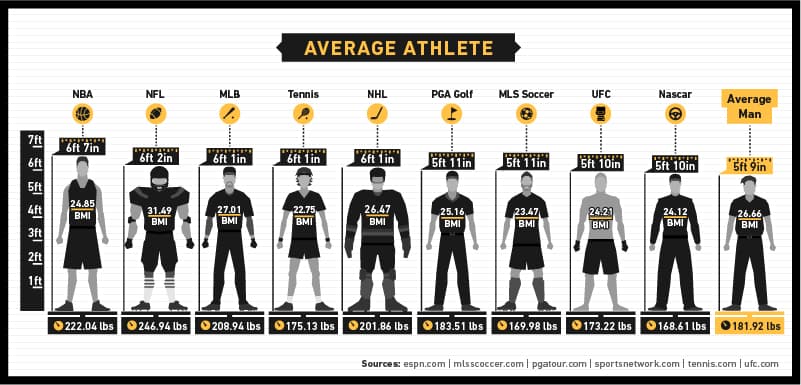
Because of the basic differences in athletic abilities needed for various sports, each sport averages a different body type standard. For instance, NBA players had the highest average height out of any sport, at a staggering 79.2 inches – 5 inches more than the runner-up, NFL players. And NFL players had the greatest average weight at 246.9 pounds, nearly 25 pounds more than the average NBA player. In terms of body mass index (BMI), a relationship between height and weight that does not take into account body fat percentage, NFL players had the highest BMI of all at 31.5, while pro tennis players had the lowest at 22.8.
Due to the diversity of these body types, each can have a very different impact on men’s body anxieties as well – especially on male athletes themselves. The average man has a BMI of 26.66 and a weight of 181.9 pounds and would have to gain a substantial amount of weight, largely in muscle, to approach the most common body types in the NFL and NBA. Muscle dysmorphia, a condition of men who continually believe they aren’t muscular enough, has been described as a “reverse anorexia.” This condition can be characterized by an unhealthy preoccupation with frequently working out and a highly regimented diet focused on gaining weight. Sufferers of muscle dysmorphia may experience depression and anxiety as well as a serious impact on their work and social life; they may also engage in steroid abuse in order to achieve a highly muscular body shape.
The struggle to achieve a perfect physical ideal can give rise to body dysmorphia, disordered eating, purge behaviors including excessive exercise, and abuse of pharmaceuticals that include laxatives and stimulants, or illicitly obtained anabolic steroids. Ultimately, this quest has very little to do with health – a fact made evident as one’s mental and physical well-being quickly fall by the wayside. If eating disorders and their related consequences are challenging your attempts to lead a normal and healthy life, call . Treatment support advisors are available to provide more information about recovery options.
Need Help With an Eating Disorder? Virtual Online Treatment is Here!
Insurance Options Available.
The Average Man
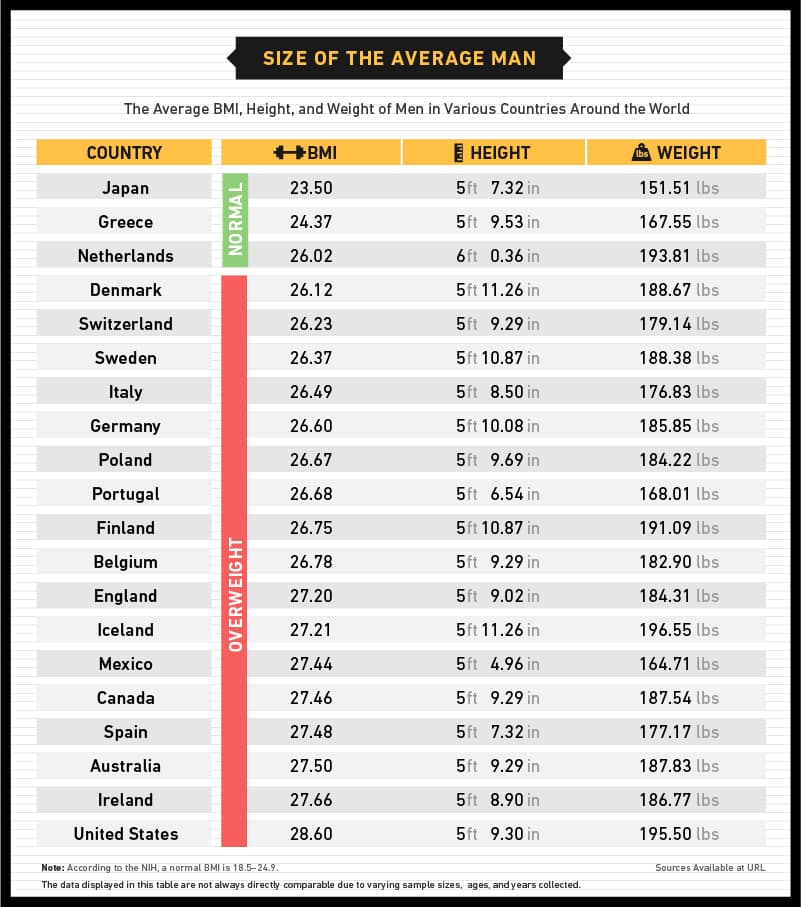
In addition to the significant variation between body types of athletes in different sports, the average man’s BMI varies substantially around the world. For instance, while men in the U.S. have an average BMI of 28.6 and a weight of 195.5 pounds, men in Japan have a BMI of only 23.5 and a weight of 151.51 pounds. It’s important to note that the data displayed in this table are not always directly comparable due to varying sample sizes, ages, and years collected. Although eating disorders have been historically uncommon in non-Western nations, these conditions may be on the rise globally due to the influence of Western media’s body images, and national variation in body sizes may put many men at an even greater disadvantage when seeking to match these ideals.
Comparing the Two
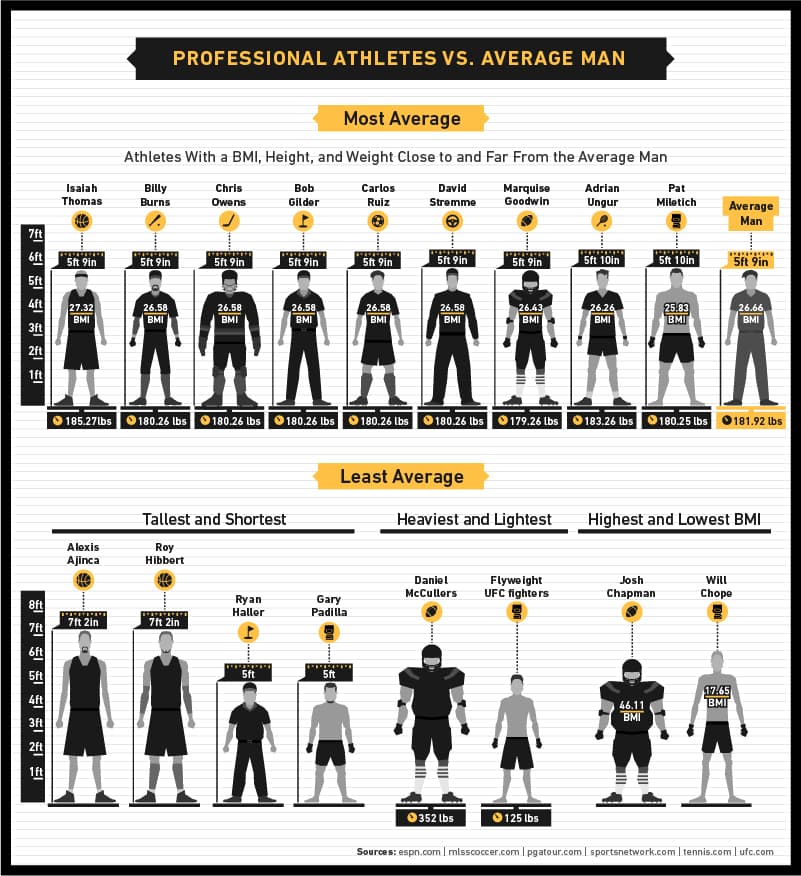
Professional sport is all about the extremes of physical ability, and we analyzed the stats of U.S. pro sports players to identify the biggest, smallest, and most average players. As you might expect, the tallest players overall were from the NBA, with Alexis Ajinca and Roy Hibbert tied at 7 feet 2 inches. Meanwhile, the shortest were golfer Ryan Haller and UFC fighter Gary Padilla, both at an even 5 feet 0 inches. The heaviest player amongst all major league sports was the NFL’s Daniel McCullers at 352 pounds, while the lightest would fall into the UFC’s flyweight class at 125 pounds.
However, we also looked at the athletes who most closely aligned with the BMI, height, and weight of the average man. Among the NBA, the “most average” player is Boston Celtics point guard Isaiah Thomas at 5 feet 9 inches and 185 pounds, while Olympic athlete Marquise Goodwin is the most typical among the NFL.
Height, Weight, and BMI of Athletes in the NFL, NBA, MLB, and NHL
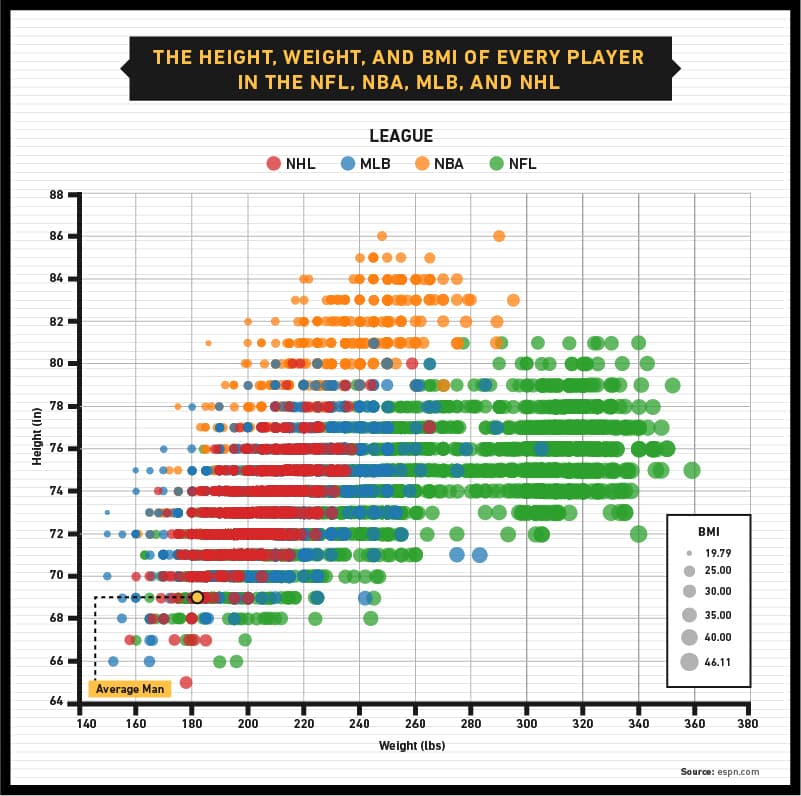
Using the stats of every player in the NFL, NBA, MLB, and NHL, we charted individual body sizes throughout these four major leagues to see which patterns emerged. As we’ve seen, NFL players tend toward greater weight and higher BMI, whereas NBA players show a greater height than any other sport. However, we can see that in comparison, MLB players tend to be both shorter and less heavy, and NHL players typically have even smaller body sizes. These are sports where the extremes of height or weight provide less of an inherent advantage to players, who must rely on other skills and abilities.
Average Baseball Players’ Sizes Over Time
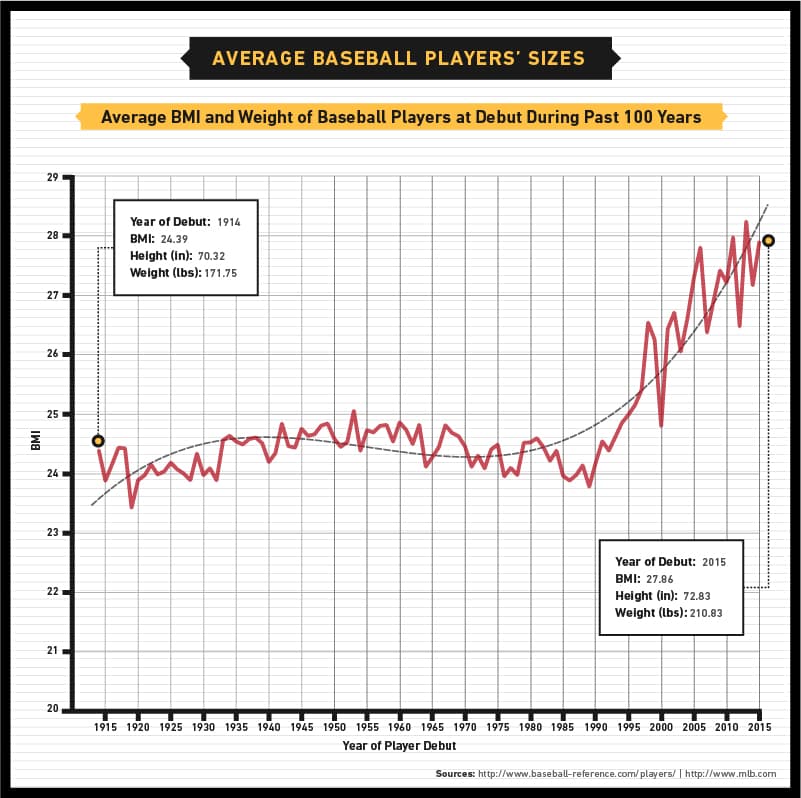
One notable sport for which pro players remain relatively close to the average man’s BMI is major league baseball. The popular national pastime featured players with an average BMI of 26.54 in 1998, 27.21 in 2010, and 27.86 in 2015, approaching the average U.S. man’s average BMI of 28.6. But while many men would be able to meet these size standards, it’s an altogether different matter whether they could achieve the same physique, and these ideals can worsen the body dissatisfaction that can contribute to eating disorders.
Men are influenced, perhaps more than ever, by media depiction of an athletic body ideal but are given little in the way of healthful guidance in how to approximate it. Left to their own devices, many people opt for methods that are anything but healthy. If you find yourself locked in an unhealthy struggle to change your body and fell you may already be suffering the mental and physical consequences, call – speak in confidence about your issues with someone who can provide helpful information about eating disorder and other treatment programs.
Collegiate Athletes Compared to the Pros
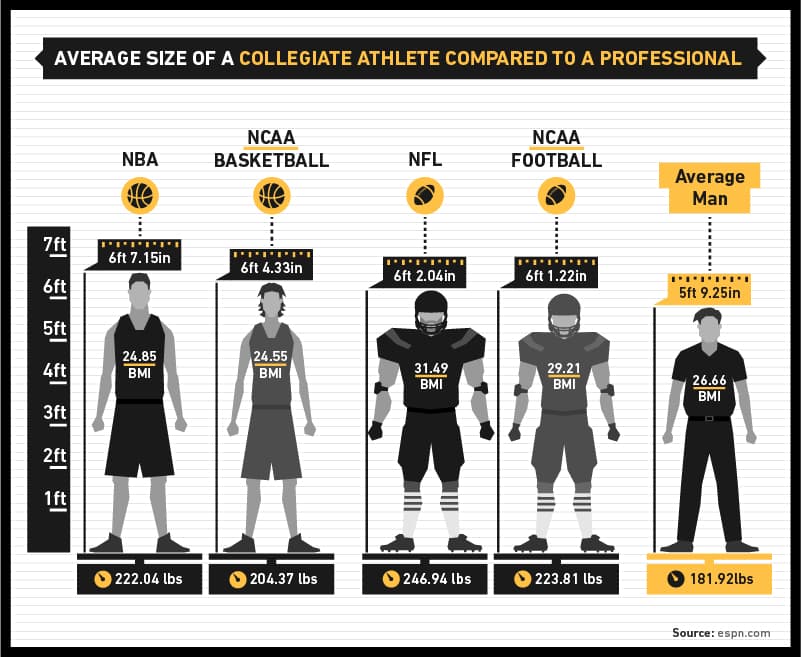
It’s not just the average man whose physique is far from that of major league players. Even the average collegiate basketball and football players don’t match the body size of NBA and NFL athletes. The average NCAA basketball player is still almost 3 inches shorter than the average NBA player, and almost 18 pounds lighter. And the typical NFL player is 23 pounds heavier than the average NCAA football player.
Male athletes actually face some of the highest risks of eating disorders and unhealthy body image. These athletes are subject to pressures to perform, constant evaluation and scrutiny of their abilities, and the weight limits inherent to their sport. These pressures can lead to body dissatisfaction, influencing the development of disordered eating behaviors and excessive exercise.
Average Sizes by Position of Collegiate and Pro Athletes
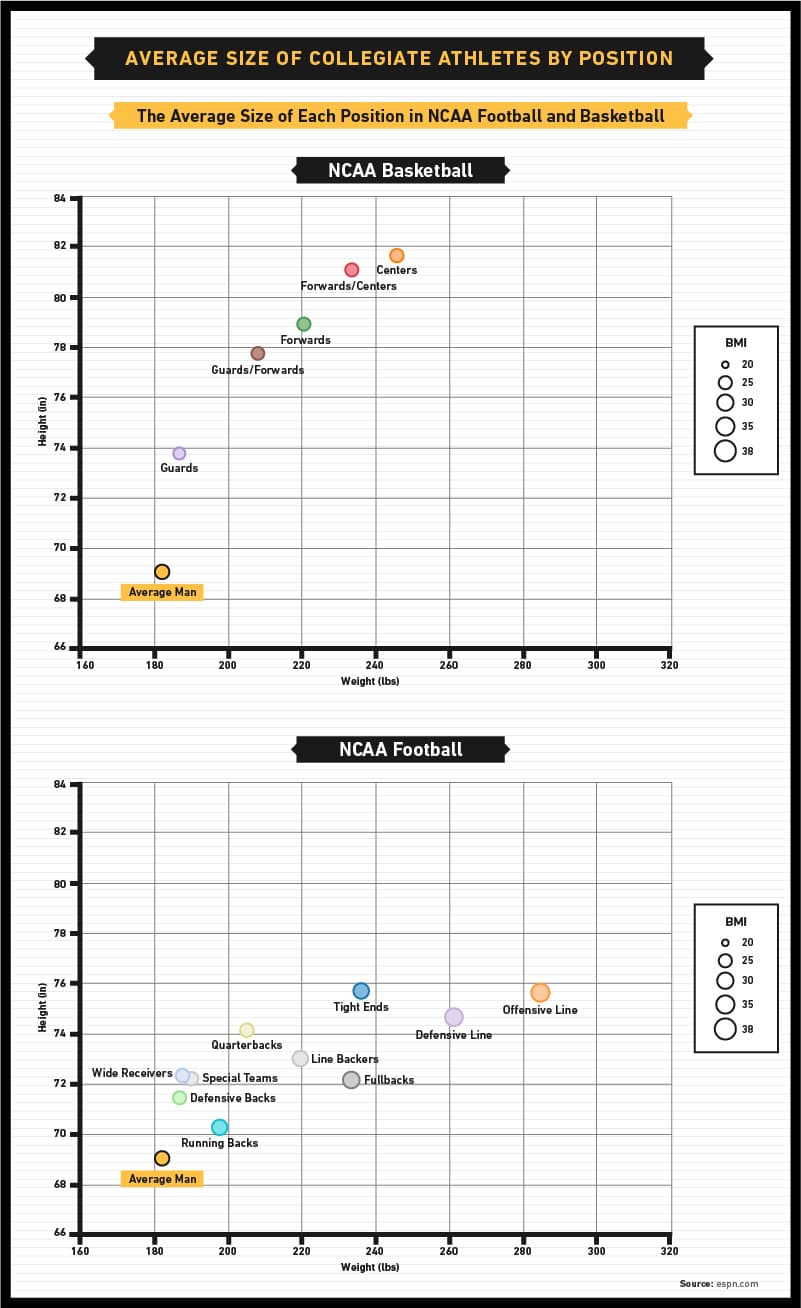
We also looked at the body size statistics for different positions among NCAA basketball and football players. As you might expect, basketball players trend toward a greater height, while football players trend toward higher weights. Similarly, BMI tended to be greater among football players than basketball players. The overall tallest body sizes are occupied by center and forward/center positions in basketball, both exceeding 6 feet 8 inches on average. In NCAA football, the heaviest body size is that of the offensive lineman, who weighs an average of over 280 pounds.
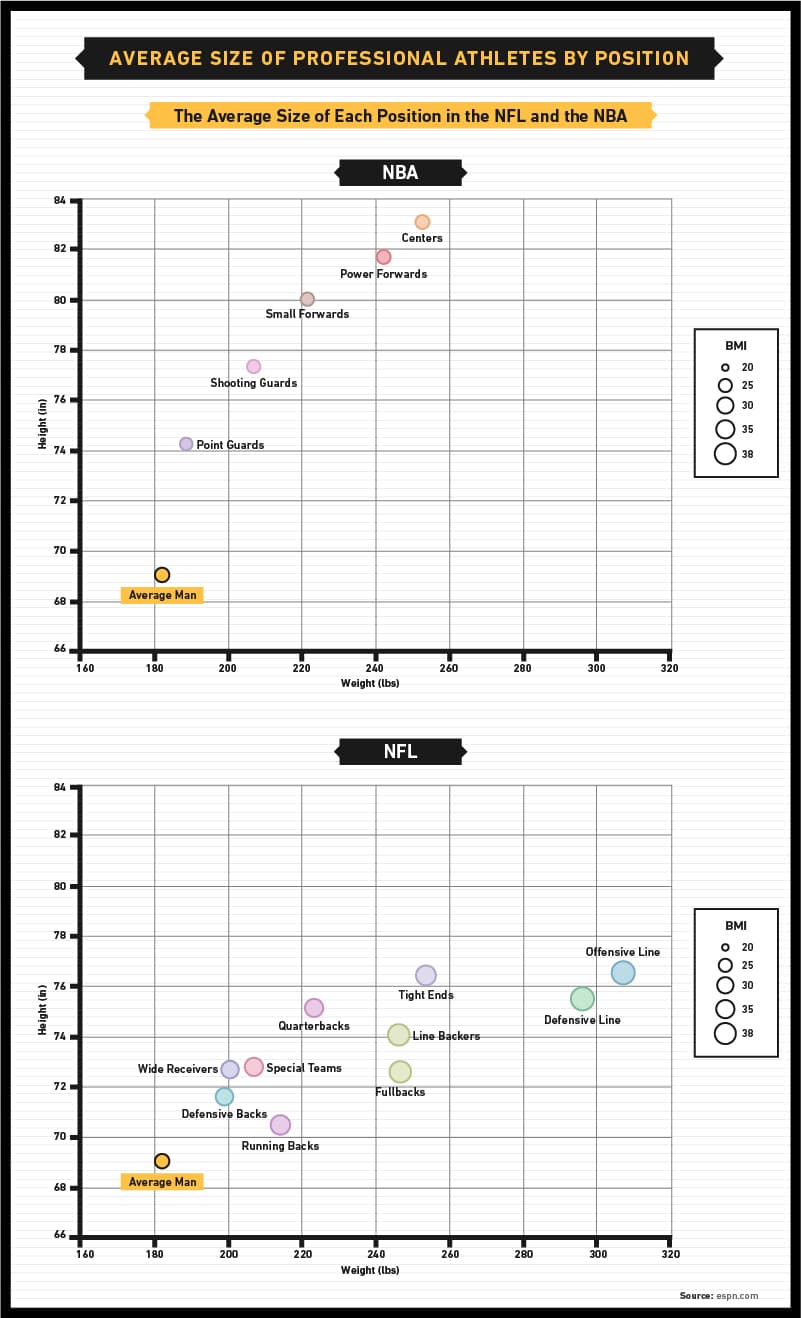
When we analyzed the typical body sizes among different positions in the NBA and NFL, the trend of increased body size in the major leagues became even clearer. As with NCAA basketball players, centers and power forwards remain the top NBA players by average height – but NBA centers are an average of 6 feet 11 inches. NFL players also exceed the average body size of NCAA football players, with pro offensive linemen weighing over 300 pounds on average. These substantial differences further illustrate pressures of body size and shape on collegiate athletes who face fierce competition to reach the major leagues.
Eating Disorders Among Collegiate Athletes
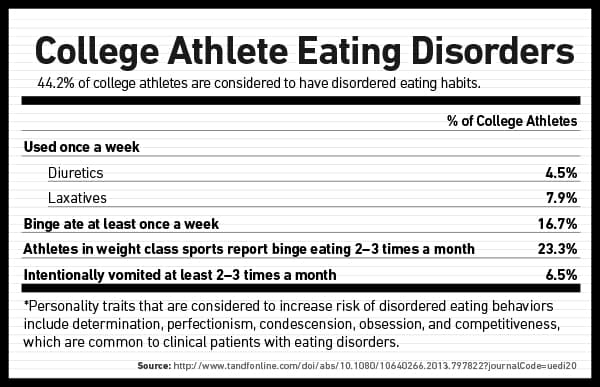
Make no mistake: The pressures of an ideal athletic image can be actively damaging to health. A recent study has revealed that male collegiate athletes engage in unhealthy and dangerous weight control behaviors at staggering rates.
In the study, 16.7 percent of players reported binge eating at least once a week, and 6.5 percent induced vomiting at least two to three times a month. In addition, 7.9 percent used laxatives once a week, and 4.5 percent used diuretics once a week – with 23.3 percent of athletes in sports with weight classes reporting binge eating two to three times a month. Vomiting and other purging behaviors can lead to digestive problems, tooth erosion, esophageal inflammation, and electrolyte imbalance that can cause arrhythmia and even death. In the pursuit of a “perfect” figure, these athletes risk severely harming their bodies and their health.
Seeking Help for Eating Disorders and Body Dissatisfaction
Men face a variety of social pressures to attain an ideal, trim, muscular image, and these influences can push them to an unhealthy extreme. If getting fit has turned into a harmful compulsion, know that help is available.. Professional assistance as part of a tailored treatment program has helped many regain control of their lives and health. Visit PsychGuides.com today – peruse our informational pages and/or utilize our state treatment directories to find the help you need to achieve the well-being you deserve.
Fair Use
Feel free to use any of the assets found on this page. In doing so, we ask that you give credit to the creators by linking back to the original project, which allows your audience to explore other elements of the project and methodology.
Sources
http://www.espn.com/
http://www.mlssoccer.com/
http://www.pgatour.com/
http://www.sportsnetwork.com/
http://www.tennis.com/
http://www.ufc.com/
http://www.baseball-reference.com/players/
http://www.webmd.com/mental-health/eating-disorders/features/guys-eating-disorders
http://www.ncbi.nlm.nih.gov/pubmed/24183132
http://www.nlm.nih.gov/medlineplus/ency/article/000341.htm
https://www.womenshealth.gov/publications/our-publications/fact-sheet/bulimia-nervosa.html
http://www.ncbi.nlm.nih.gov/pmc/articles/PMC4392812/
http://psycnet.apa.org/psycinfo/2013-07333-001/
http://www.ncbi.nlm.nih.gov/pubmed/23302755
http://www.ncbi.nlm.nih.gov/pubmed/24936895
http://cdn.intechopen.com/pdfs/29049/InTech-Westernization_the_role_of_mass_media_on_body_image_and_eating_disorders.pdf
http://www.tandfonline.com/doi/abs/10.1080/10640266.2012.715515?journalCode=uedi20#.VZwGzvlViko
http://www.sciencedirect.com/science/article/pii/S1469029213000873
http://www.tandfonline.com/doi/abs/10.1080/10640266.2013.797822?journalCode=uedi20&#preview
http://www.statistics.gr/portal/page/portal/ver-1/ESYE/BUCKET/A2103/Other/A2103_SHE22_MT_5Y_00_2009_00_2009_01_F_EN.pdf
https://www.destatis.de/EN/FactsFigures/SocietyState/Health/HealthStatusBehaviourRelevantHealth/Tables/BodyMassIndex.html
http://www.pisa2006.helsinki.fi/finland/statistics/statistics.htm
http://www.oecd-ilibrary.org/sites/soc_glance-2008-en/07/05/index.html;jsessionid=2r3gn9g8vin7x.x-oecd-live-02?contentType=&itemId=%2fcontent%2fchapter%2fsoc_glance-2008-26-en&mimeType=text%2fhtml&containerItemId=%2fcontent%2fserial%2f19991290&accessItemIds=%2fcontent%2fbook%2fsoc_glance-2008-en
http://www.bbc.com/news/uk-11534042
http://www.nature.com/pr/journal/v73/n3/pdf/pr2012189a.pdf
http://www.abs.gov.au/ausstats/abs@.nsf/Lookup/4338.0main+features212011-13
http://www1.imperial.ac.uk/publichealth/departments/ebs/projects/eresh/majidezzati/healthmetrics/metabolicriskfactors/metabolic_risk_factor_maps/
http://www.cdc.gov/nchs/fastats/body-measurements.htm
https://apps.who.int/infobase/Indicators.aspx
Methodology
Using import.io, a tool that allows users to crawl websites and extract data, we pulled male athletes’ online player profiles, which included heights and weights as well as information on hometowns and countries. Given the height and weight of each athlete, we were able to calculate his BMI. We compiled all the data we scraped, as well as our BMI calculations, and we used them to determine the average height, weight, and BMI – along with nationalities when applicable – for each athlete and his respective sport.
In addition, we collected the height, weight, and BMI data of the average male from the United States and other various countries to compare the sizes of average males to athletes. For some countries, only heights and BMIs were available; therefore, we had to calculate the average weight based on this information. In addition, the heights, weights, and BMIs of the average male of other countries came from various sources. Because of the different sources and various years the data were collected, the size of the men around the world are not directly comparable.

